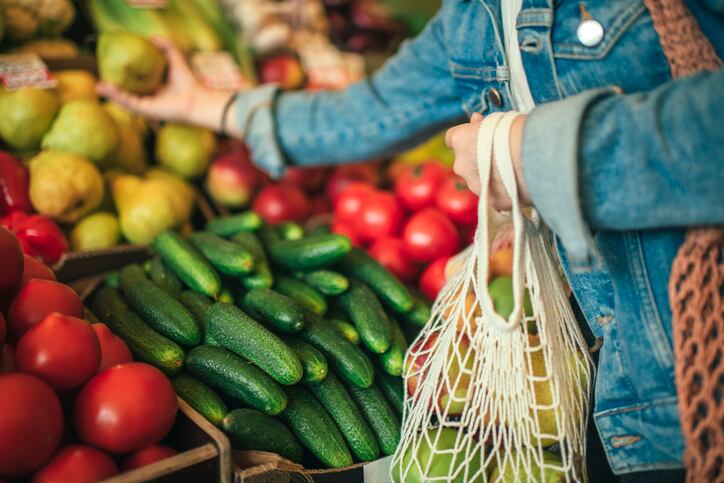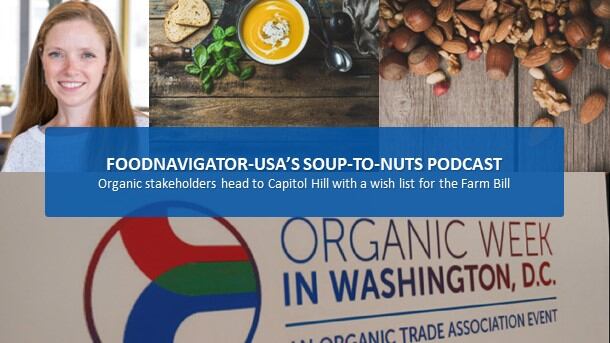While the organic industry wants to protect consumers and its market share against greenwashing, some stakeholders wonder if a “yes, and” approach, rather than an all-or-nothing approach, would more effectively counter-climate change by encouraging farmers and consumers to take smaller, but potentially more accessible, steps towards sustainability.
At the Organic Trade Association’s annual conference in Washington last week, members debated the value and impact of eco-claims beyond organic to promote holistic change to agriculture systems and if or how organic should respond to simultaneously reinforce shared values without compromising its competitive edge.
“Eco labels … are everywhere. There are the old ones, like Organic and Fairtrade and Rainforest Alliance, all the way around to regenerative, net zero, carbon neutral, and [claims about] plastics, fish and wildlife. Every week, every month there is a new label or new claim coming out,” Paul Schiefer, president of Amy’s Kitchen, told attendees at OTA’s conference.
He joked that when these claims and certifications are grouped together on packages they cause some foods to look like cars racing in NASCAR.
He added that while many claims and environmental certifications may be redundant or make packaging appear cluttered, “they are here for a reason. They are speaking to consumer demands. They are speaking to environmental and social impacts that brands wish to make, and they are the kind of choices that people make when selecting brands and products.”
Many consumers are also willing to pay a premium for products that make claims that appear to align with their values, added Krista Kinder, VP of brand marketing & communications, Organically Grown Company.
Unfortunately, Schiefer noted, “sometimes claims can [appear to] meet the value proposition for consumers that they might not credibly have earned.”
In other words, consumers are confused, he said. He explained: Most do not understand the benefits that USDA Certified Organic offers and that it encompasses many of the popular single-attribute claims, such as non-GMO. Nor do they understand top competing eco-claims, such as regenerative.
When are single-focus claims a benefit versus a competitive threat?
OTA and many organic players are aggressively educating consumers about what USDA Organic represents, why it is worth a premium and how it stacks up to other eco-claims. And while these efforts are championed by many in the organic industry, some wonder whether there might be room for other claims to act as stepping stones for farmers, manufacturers and consumers that cannot afford or access organic certification or products to still help move the needle to a more sustainable future.
“There may be [claims that] are capturing something that we know is very specific that consumers, that shoppers care about, but that may not be specifically addressed within the organic label,” such as free range or plastic-free, Kinder said. “We have to be super honest with ourselves about the job that individual, single-focus labels can do and they are a really quick get for shoppers of the shelf.”
She argued that any support for these claims must be balanced with efforts to educate consumers about other claims that are “either underdefined or completely undefined and unregulated.”
On the spectrum: Is regenerative ‘beyond organic’ or ‘beyond conventional’?
Regenerative is emerging as a posterchild for the types of undefined claims that rankle some in the organic industry, even though several certifications of varying rigor exist for regenerative.
But not everyone in the industry sees them as competitors, but rather as complementary or at a minimum on the same path to a shared goal.
“There are two camps for regenerative,” Derric Pennington, senior sustainability scientist, Department of Applied Economics, University of Minnesota, postulated at the OTA conference.
The first camp views the current USDA Organic standards as “watered down” and less rigorous than the individual standards that were used before industry came together with the government to create the National Organic Program (NOP) and define, regulate and enforce organic, he said.
“These folks see regenerative as ‘beyond organic,’” because it can incorporate some elements of organic pre-NOP, or because they do not want the government involved or to be told what to do, he added.
The second group sees regenerative as beyond-conventional but not quite as high a bench mark as USDA Certified Organic, he said. They see it as offering slight tweaks to the current supply chain to encourage farmers to adopt more sustainable practices than conventional but without going all in on organic certification, which with its three-year transition period can be financially out of reach for some stakeholders, he said.
Either way, Pennington said he believes regenerative is the new “sustainable,” meaning it has the potential to drive positive change but faces accountability challenges given it does not have the same enforcement teeth of USDA Organic.
The ‘upside’ of regenerative’s rise
Applegate is among the companies that have long-supported organic, but which also sees potential for regenerative to encourage adoption of more sustainable practices.
“At Applegate, we have organic, non-organic and regenerative products in our portfolio. This year we announced a goal to transition all of the beef used in our hotdogs to be sourced from certified regenerative farms by the end of 2025,” said Carolyn Gahn, senior director, mission & advocacy, at Applegate.
She acknowledged that there “is a lot to unpack” around this decision and that most consumers do not know what regenerative means. But she suggested the “upside” of the attention paid to regenerative at this point in the adoption cycle is with influencing companies’ procurement policies.
“We have people in all levels of companies talking about these concepts of no till, soil health and these environmental things that a consumer does not understand. But now we have people in procurement and other areas of companies who are starting to wrap their minds around how this all works, where they did not before,” and that is creating new opportunities to establish corporate accountability metrics, standardized frameworks, and adding more circularity, transparency and traceability to the supply chain, she said.
She added that Applegate now works with more farms that are measuring ecological outcomes, adopting habitat restoration, cover cropping, and other practices that work towards the same goal of restoring soil health as organic.
“The majority of the acres in the country are in conventional ag,” and while greenwashing is a concern, so too are the damaging effects of conventional farming, and regenerative and organic both want to kickstart more conservation practices, she added.
Beyond regenerative: Providing tools to adopt organic practices
Recognizing the shared threat of conventional farming that both organic and regenerative are trying to address, and the shared struggle with consumer confusion, Organically Grown Company created an open-source campaign to educate shoppers about the true value of organic.
The ‘Organic Is The Answer’ campaign allows consumers to explore the benefits of organic and includes a “collection of robust tools that anyone can use,” repurpose and make their own, Kinder said.
“It is supposed to help in any way that it can … in telling your stories – so check it out,” Kinder encouraged.




